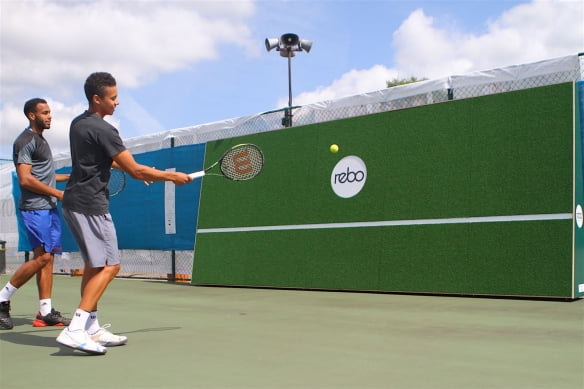
Hitting Wall
Originally published on 29/06/18 00:00
Who doesn’t enjoy hitting a ball against a wall? It isn’t guaranteed to make us all champions, but it’s a great way for more serious players to hone their skills and for new players to get the feel of ball on racket. Unlike with a ball machine or a sparring partner, the ball always comes back to you.
Adrian Hutchins is the founder of REBO wall, a UK-based company set up in 2014 that produces uniquely adjustable, angled hitting walls and an accompanying series of ‘REBO coaching’ drills and games. The walls, which are either rigid or inflatable, can be installed virtually anywhere as either permanent or temporary structures.
“We have received a lot of positive feedback about REBO’s mission to get people more active,” Hutchins said, “and we have recently been getting some really good international traction.”
Hutchins has started evolving the company’s products and believes he has made them both better and less expensive. Take the Wimbledon ‘Pro’ REBO wall, which is the largest in the range, starting at three metres wide.
“The ‘Pro’ REBO wall now has a fully adjustable surface,” Hutchins explained.
“The first version was set at nine degrees off the vertical. The angle was specifically set to provide a good all-round response, so the ball would rebound in an arced flight, not a downward trajectory like you experience from a vertical wall, making the contact point of the ball more natural. If players want a faster response now they can adjust the angle of the wall, which will change the speed and flight of the ball.”
The ‘Pro’ REBO wall is also cheaper than the first version. It is now flat-packed and installed without REBO’s installation specialists. The specialists are still on hand to help if required, but Hutchins thinks the product is now much more versatile. The first adjustable wall has been shipped to South Carolina in the United States.
Closer to home, Loughborough University Tennis Centre has invested in four portable walls. These are inflatable ‘Speed’REBO walls. The Loughborough coaching team, under the supervision of David Boddy, the Tennis Coach Development Manager, move the walls around the university campus, partly as a marketing tool to invite all students to come and play and promote the tennis facilities.
“We took walls to all the halls of residence during freshers’ week,” Boddy said. “Each hall had a champion – the person that maintained the longest rally against the wall – and then we brought all the winners together and had a competition. It was a way of engaging with various people on site without needing a traditional court.”
Boddy also uses the walls in coaching sessions with youngsters. “I think what is quite nice about them is that they are a bit ad hoc as well,” he said. “The sessions don’t have to be structured all the time as people find different ways of playing against it. Sometimes by just letting kids have a go against the walls they come up with their own games – they are far more inventive than we are! As coaches that’s quite useful.”
Boddy and his team use the walls for cardio tennis too. The walls can be customised with logos and moved anywhere. “You can deliver something in a small area,”he said.
By way of contrast Cumberland Tennis Club in Hampstead, London has installed a Wimbledon ‘Pro’ REBO Wall, for use by the members. “It’s a nice thing for us to have as an extra facility for the membership,” Simon Harmer, the General Manager, said. “It gets used daily, probably 60-40 juniors to adults. A lot of adults are finding it is quite good to warm up when they are waiting for their opponents to come. We also have a few people who use it to help return from injury and a few older players who like to use it for gentle exercise. It has a wide-ranging player base.”
Hutchins says there are now more than 100 REBO walls installed around the world, which is an important milestone for the business. He is also getting a lot of interest in his Legacy Project, whereby walls can be customised either by individuals who wish to donate something to a club or by local businesses, who can use the wall to promote their products or services. The walls can therefore offer a new revenue-generating opportunity for clubs.
However, it is not all about tennis clubs. One of the projects closest to Hutchins’ heart is installing walls in urban areas and encouraging people to play. One such project is in Totton, near Southampton.
Hutchins thinks the decorated double-sided concrete walls are great in the community. “On one side you can have a footballer, reminding us that the likes of David Beckham once kicked a football against a wall, and the other side a tennis player,” he said. “That’s giving people a double reason to use the walls
This feature first appeared in the summer 2018 edition of tennishead magazine.
You can find tennishead magazine in good retailers or subscribe and never miss an issue


